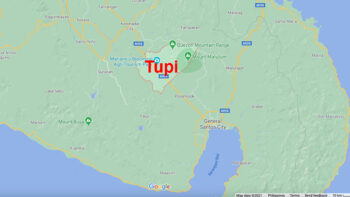DAVAO CITY (MindaNews / 28 November) — High-risk barangays of Davao City will not be put on “hard lockdown,” according to Dr. Ashley Lopez, City Heatlh Officer and focal person for coronavirus disease (COVID-19) of the Department of Health (DOH) in the city.
Lopez told Davao City Disaster Radio (DCDR 87.5) on Thursday that the local government will continue the implementation of house lockdown, particularly for individuals who have close contact with a COVID-19-positive patient, and will isolate confirmed cases in facilities.
“The most that we can do is house lockdown for now, most especially when we identify positive cases, we need to lockdown the houses of their close contacts because they should not be allowed to leave as they can be the source of transmission,” he said.
 Davao City reverted to General Community Quarantine (GCQ) from Modified GCQ effective November 20 until November 30.
Davao City reverted to General Community Quarantine (GCQ) from Modified GCQ effective November 20 until November 30.
Lopez said that even the Coordinated Operations to Defeat Epidemic (CODE) team did not enforce barangay lockdown or community lockdown in Pagadian City in Zamboanga del Sur, Bacolod City, Cebu City, and areas in National Capital Region to address the surge in transmissions there.
He added that the government may consider enforcing barangay lockdown only when a significant number of the population will test positive for COVID-19.
“If we can identify cases more than 10% of the population of one barangay, that’s probably an indication that we have to initiate lockdown on barangay or a compound. But based on the experience of CODE team, they did not impose barangay lockdown in any place,” he added.
In her regular program over DCDR 87.5 on Friday, Mayor Sara Duterte reiterated her stance against a city-wide lockdown, claiming it is unsustainable.
“The discussion of Davao City COVID-19 Task Force is not going to that direction,” she said.
She added that the short-term lockdown will not solve the problem on transmission because a resurgence in the transmission will happen once the city reopens.
“Short-term lockdown will not solve anything. Maybe one or two years of lockdown can solve the problem of transmission but it is not sustainable, and it is not reasonable… that would have been ideal because we can look for those infected easily, and the transmission can be stopped since only a few people can go out,” she said.
During the CODE meeting with COVID task forces in the region last November 18, Dr. Alethea De Guzman of the DOH-Epidemiology Bureau said most of the cases during the first half of November came from Buhangin Poblacion, Barangay 19-B, Talomo Poblacion, Agdao, Bucana, Toril Poblacion, Matina Crossing, Ma-a, Matina Aplaya, Cabantian, Catalunan Grande, Sasa, Panacan, Barangay 21-C, Pampanga, Daliao, Calinan Poblacion, Barangay 5-A, Bago Aplaya, Barangay 27-C, Centro (San Juan), Tugbok Poblacion, Leon Garcia, Sr., Barangay 32-D, Barangay 9-A, Baliok, Barangay 20-B, Tibungco, Bunawan Poblacion, Lizada, Tigatto, Barangay 28-C, Barangay 7-A, and Indangan.
Cases from these areas contributed 80-percent of the total COVID-19 cases out of the 96 barangays with reported cases in the first two weeks of November. The city is composed of 182 barangays.
As of November 27, Davao region recorded 8,881 cases with Davao City accounting for 70.1% at 6,228 cases; Davao de Oro with 448, Davao del Norte with 994, Davao del Sur with 670, Davao Occidental with 116, and Davao Oriental with 425.
The entire region has 2,590 total active cases, 5,947 recoveries, and 344 deaths.
Out of the 6,228 cases in Davao City, 2,097 are active, 3,845 are recoveries, and 286 are deaths. (Antonio L. Colina IV / MindaNews)
